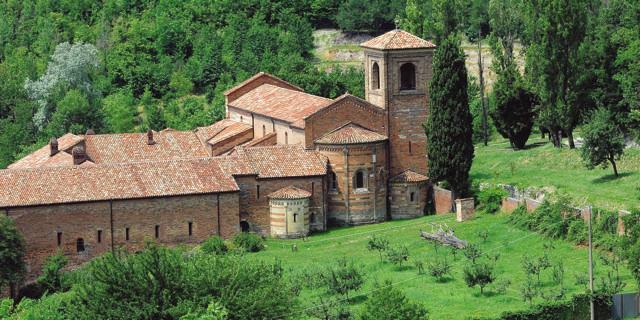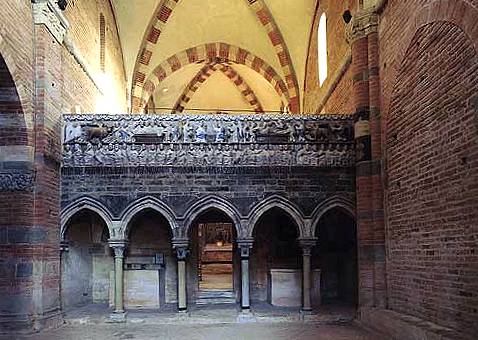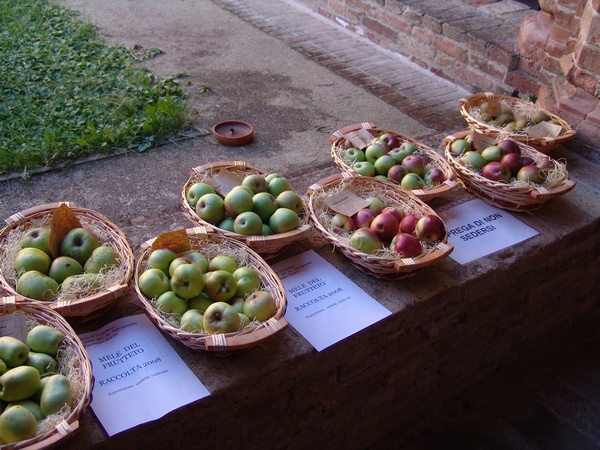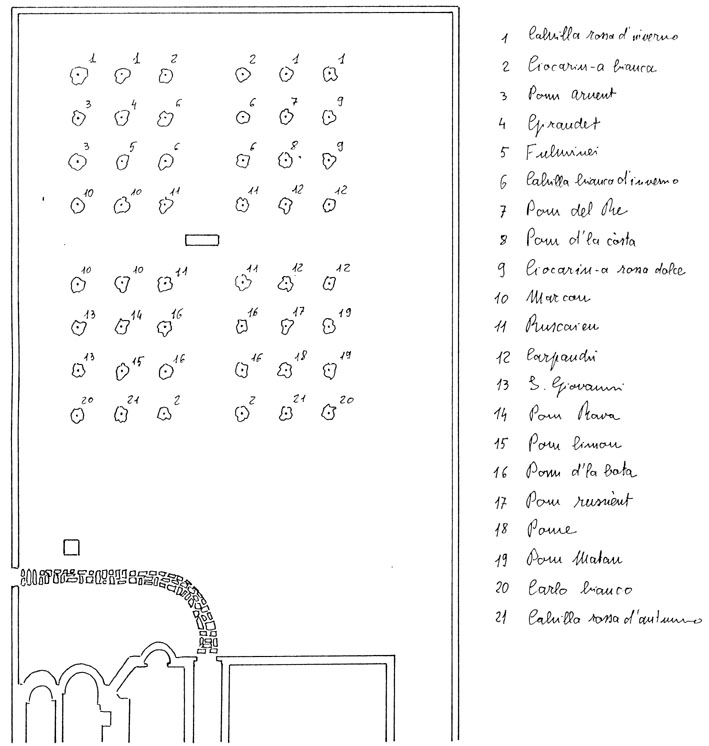
Abbazia di Vezzolano
This post is also available in:
 Italiano (Italian)
Italiano (Italian)
The monumental complex of Santa Maria di Vezzolano and the basin that includes it, which extends within the territories of Albugnano, Moncucco and Castelnuovo Don Bosco, are protected by national and regional laws on monument and landscape heritage.
The Abbey of Santa Maria di Vezzolano is a Gothic and Romanesque style religious building – one of the most important medieval structures in Piedmont, located in the municipality of Albugnano (province of Asti).
According to a legend, the church was built at the time of Charlemagne; according to the most reliable version of the story, in 773 the emperor was hunting in Vezzolano forest, when three skeletons suddenly emerged from a tomb, giving him a good scare. Helped by a hermit and invited to pray to the Virgin Mary, he decided to build a church and an abbey in that very place.
When it comes to historical records though, the abbey was already there during the Kingdom of the Lombards (in the latter part of the VI century) and it was later enlarged, enjoying more and more fame and wealth. In the X century, the abbey was destroyed by the Saracens, rebuilt and donated by Arduino king of Italy to Oddone di Bruzolo in 1002: the latter then left it to his descendants who, in turn, gave it to the provost of Vezzolano in 1095. The abbey was inhabited by the Benedictine friars until the early XIX century, during the Napoleonic domination.
Behind the church of Vezzolano, a handful of volunteers have recovered a unique piece of that ancient history for some ten years: it is not a work of art like the splendid monastery, on the contrary, it’s rows and rows of the very small plants that the monks used to painstakingly care for. For that reason, in 1996 the Superintendence of Environmental and Architectural Heritage of Piedmont, on the occasion of the 9th centenary of the abbey, entrusted this piece of land to some volunteers, so that they could restore it to its original splendour. The group formed a special committee (“Comitato per la salvaguardia del paesaggio rurale: frutteto della Canonica di Vezzolano”) and their endeavour was described by Ludovico Radicati di Brozolo in his “Quaderni di Muscandia” as follows:
“The Committee decided to recreate an orchard similar to the one cultivated in the ancient monastery. It was decided to cultivate the apple trees because they’re better suited to the climate of Northern Italy, to the soils of the Piedmont hills and for their greater resistance to parasites. Thus, now the variety of apple trees offers different colours, tastes and ripening times: “San Giovanni apples are ready in the summer, “Ruscaieu” and “Pom Matan” in the winter. Then, there are “Carpandù”, “Pom d’la bota”, “Pom Arnent”, “Giraudèt”, “Pom d’la costa”, “Fulminei”, “Pom rusnènt”, “Ciocarin-a” – white or sweet red, “Pom limon”, “Pom del re”, “Pom Rava”, etc…”
Currently cultivated apple varieties:
Calvilla rossa d’inverno
Medium-sized, elongated. Waxy skin, burgundy red colour. Firm, crunchy, moderately juicy pulp. Harvested at the end of October, can be eaten from December to March.
Ciocarin-a bianca
Elongated shape, smooth, yellow skin tinged with red. Crunchy, sweet pulp.
Harvested in early October, it can be stored until March.
Pom arnent
Rounded with rough, rusty skin. Sweet crunchy pulp.
Harvested in early October, it can be stored until March. Suitable for cooking.
Fulminei (Firminei)
Flattened shape, medium size. Rough greenish skin. White pulp, juicy, sweet and sour.
Harvested at the end of October, it can be stored until April.
Calvilla bianca d’inverno
Medium-sized, rounded, with ribs in the calyx area. Smooth, waxy, thin, yellow skin. Crunchy, juicy, sweet-sour, fragrant pulp.
Harvested in the first half of October, it is eaten from November to April. Its origins are very ancient.
Ciocarin-a rossa
Elongated shape, smooth bright red skin. Yellow, sweet, sometimes floury pulp.
Harvested at the end of September, it can be eaten until February.
Marcon
Rounded, medium-sized. Smooth skin, red-tinged with green. Crunchy, very sweet pulp.
Harvested in early October, it can be stored until April. Suitable for fresh consumption and cooking.
Ruscaieu
Rounded, medium-sized. Smooth, green skin with red spots. Sweet, crunchy pulp.
Harvested in mid-November, it can be eaten from January to May.
Carpandù
Synonym the “carpendola” variety, it has been appreciated for centuries. Several types are known. With a more or less rusty skin, yellow-green with red hues. Crunchy, sweet-sour and aromatic fine pulp.
Harvested in mid-September, it can be eaten until March.
S. Giovanni
Small, rounded fruit. Thin, straw-yellow skin. White pulp, crunchy, juicy, sweet and sour. Ripens in late June-early July, to be consumed right after the harvest.
Pom limon
Elongated shape. Yellow peel, dotted. White, acidulous, fragrant pulp.
It is harvested in the second fortnight of October and can be stored until March.
Suitable for pastries and sweets.
Pom d’la bota
Elongated shape, deep red skin. The colour is boosted by leaving the harvested apples exposed outdoors for some time. Firm, sweet-sour, juicy pulp.
Harvested in early October, ripening from December to March.
Pom d’la costa
Of unknown origin. Short, asymmetrical truncated cone shape. Smooth skin, with small, rusty lenticels. Yellow-green background colour with red shades. White pulp, crunchy, juicy, with an intense aroma.
Harvested in mid-October.
Pom matan
Large, globular fruits. Smooth, yellow skin. Sweet, yellow, crunchy pulp.
Harvested in mid-October, it can be stored until March.
Carlo bianco
It belongs to the group of “Carlo” apples, known since ancient times. The fruit is medium-small, a little elongated. Smooth, waxy, greenish-yellow skin. Firm, sweet pulp, tending to floury.
Harvested in mid-September and stored until April.
Calvilla rossa d’autunno
Another variety of the “Calvilla” group, large fruit, a little elongated. Red peel tinged with green. Crunchy, moderately juicy pulp.
It is harvested in the second half of October and starts ripening in November.
Pom rava, Pom Rusnènt, Pome
Ancient varieties present in the Orchard – no comparison has been found anywhere yet.
The local denomination of these varieties is probably known elsewhere under another name.
Pom del Re, Giraudet
Varieties present in Orchard, not yet in production.
This post is also available in:
 Italiano (Italian)
Italiano (Italian)
Contatti
Strada dell'abbazia - 14100 Albugnano(AT)
011 9920607
Altre info
Ingresso gratuito
Aperto dal Martedì alla Domenica
dalle 9.30 alle 12.30 e dalle 14.00 alle 18.30 (ORARIO ESTIVO: dal 1 marzo al 14 ottobre) o dalle 9.30 alle 12.30 e dalle 14.00 alle 17.00 (ORARIO INVERNALE: dal 15 ottobre al 28 febbraio)




